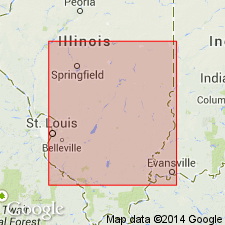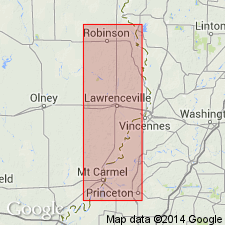
- Usage in publication:
-
- Bristol Hill Coal Member
- Modifications:
-
- Named
- Dominant lithology:
-
- Coal
- AAPG geologic province:
-
- Illinois basin
Summary:
The Bristol Hill Coal Member of the Bond Formation of the McLeansboro Group is here named in the area of Flat Rock, Crawford County, IL. It is locally called "Flat Rock Coal". At the type area the coal underlies marine limestone tentatively correlated with the lower portion of the Livingston Limestone Member of the Bond. It lies 35 to 40 ft above a black shale and thin coal correlated with the Witt Coal Member of the Bond, and 280 ft above the West Franklin Limestone Member of the Modesto Formation. Thickness is 10 in. at type section. Age is Late Pennsylvanian (Missourian).
Source: GNU records (USGS DDS-6; Reston GNULEX).

- Usage in publication:
-
- Bristol Hill Coal Member*
- Modifications:
-
- Overview
- AAPG geologic province:
-
- Illinois basin
Summary:
Paleobotanic and palynologic data from the Bristol Hill Coal Member of the Bond Formation in IL show that tree-fern species were the most dominant flora in coal swamps represented by this unit. The Bristol Hill Coal Member is 0.5 meters thick and underlies the Millersville Limestone Member or Livingston Limestone Member of the Bond Formation. The Bristol Hill is of Late Pennsylvanian (Missourian) age.
Source: GNU records (USGS DDS-6; Reston GNULEX).
For more information, please contact Nancy Stamm, Geologic Names Committee Secretary.
Asterisk (*) indicates published by U.S. Geological Survey authors.
"No current usage" (†) implies that a name has been abandoned or has fallen into disuse. Former usage and, if known, replacement name given in parentheses ( ).
Slash (/) indicates name conflicts with nomenclatural guidelines (CSN, 1933; ACSN, 1961, 1970; NACSN, 1983, 2005, 2021). May be explained within brackets ([ ]).

